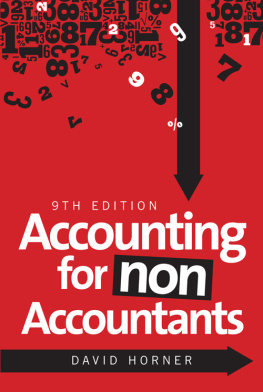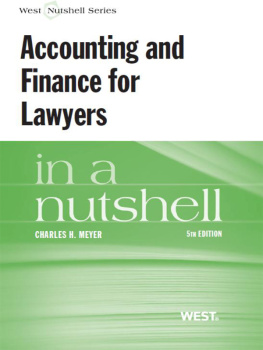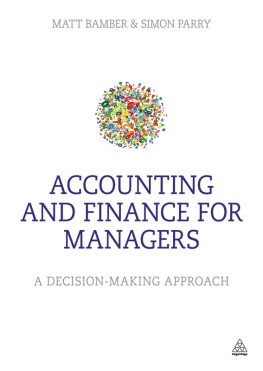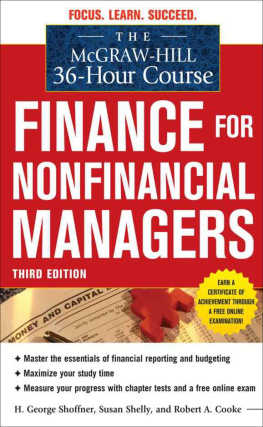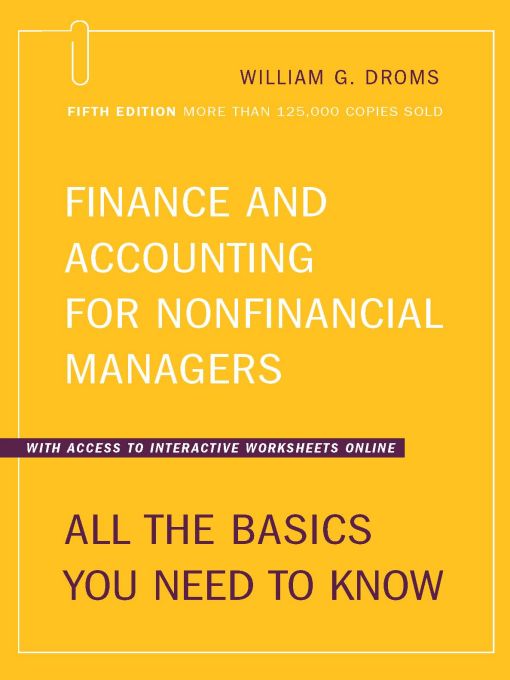
Table of Contents
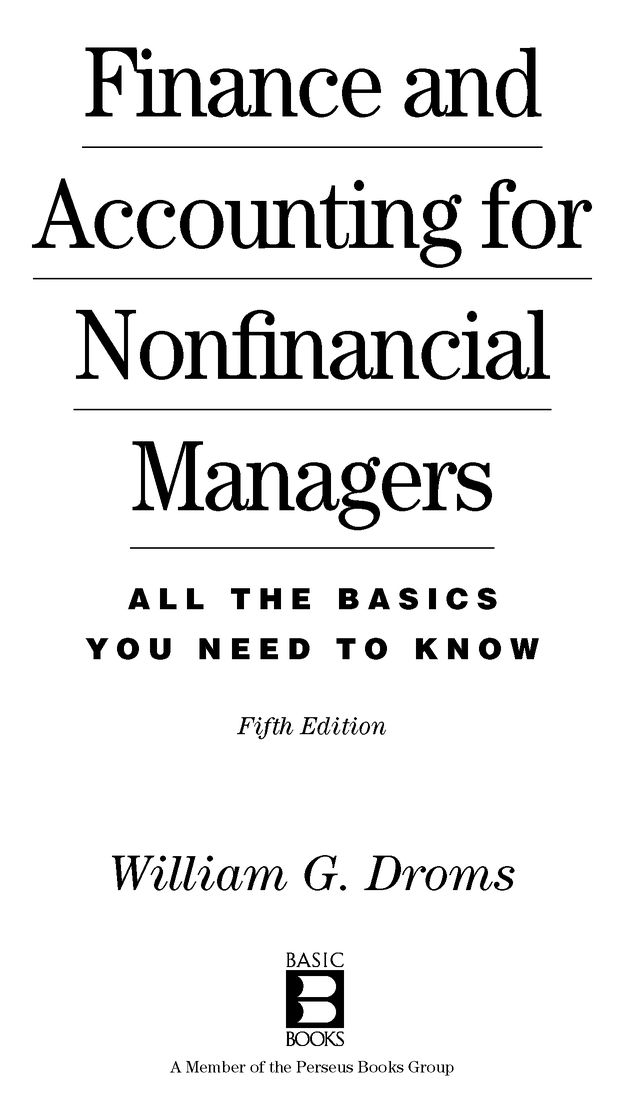
To JoAnn, Courtney, and Justin
PREFACE
This book was written in response to the demand by successful business people for additional education in the areas of finance and accounting. As this fifth edition goes to press, the Enron and Worldcom corporations have filed two of the largest corporate bankruptcies in history and, amid allegations of fraud and criminal conspiracy related to the failure of Enron, the once venerable accounting firm of Arthur Andersen and Company essentially has disintegrated after being convicted of criminal behavior related to its audits of Enron. In the midst of this period of great turmoil in corporate America, it is more important than ever that nonfinancial executives and laypersons take the time to understand the financial side of corporate operations.
The Enron and Worldcom bankruptcies resulted from allegations of widespread fraud, cover-ups, and criminal behavior by senior executives of the corporations and their auditors. Further accounting scandals are likely to come forth as the SEC, federal prosecutors, and investment analysts probe further into the published financial statements of major public corporations. Fortunately, as major public corporations come under increased public scrutiny, massive fraud on the scale of the Enron case is being shown to be the exception and not the rule. This book is designed to provide readers with the fundamental skills needed to understand the rules of the game as played by the majority of the honest participants. The text is specifically designed to appeal to managers who are relatively untrained in finance and feel the need to become better versed in order to enhance their business and managerial skills. My experience in conducting executive-level seminars designed for this audience suggests that the book will appeal to managers in all types of organizations who currently work in various nonfinancial functional areas such as marketing, production, law, and human resources management. This book also will be useful for small business entrepreneurs who feel the need to develop fundamental skills in financial control and financial planning. Finally, a variety of independent professionals, such as engineers, attorneys, and medical practitioners, may find the book useful for managing the financial side of their profession.
In addition to practicing nonfinancial managers and executives, college students with no prior formal training in accounting and finance may also find the book useful. The book may be used by itself for a one-semester undergraduate course, or it may be assigned as supplementary or background reading for a more intensive finance course. The book may be particularly appropriate for finance courses with a heavy case study emphasis where little straight text is normally provided.
In keeping with the objectives of the book, the text does not purport to provide a comprehensive treatment of the fields of finance and accounting. Throughout the writing of the book the overriding objective has been to present a few nuts-and-bolts finance and accounting concepts in order to provide usable information with immediate practical significance for the practicing manager. In this sense, every attempt has been made to provide a practical guide from which managers and executives may draw useful knowledge to be used in the normal course of business. In a similar vein, business students may find it helpful to use this book to develop a set of practical accounting and finance skills that may be applied to the analysis of business problems.
The first four editions of this book have been used successfully at a number of colleges and universities for continuing education courses in finance for nonfinancial managers, in business courses for nonbusiness majors, and in small business management and entrepreneurship courses. The book also has been used extensively for in-house corporate training programs in finance. The third and fourth editions of the book have been translated into Spanish and Portuguese and these editions have achieved some success in Europe and Latin America. The book also has been purchased by thousands of individuals for independent study. The broad acceptance of the book evidenced by sales in excess of 125,000 copies of the first four editions has provided the motivation for this fifth edition.
With the preparation of this fifth edition, I would like to thank the many students and teachers who have provided feedback from their experiences with the first four editions of the book. At Georgetown, thanks to Scott Whisenant, PhD, CPA, for patient answers to my tax and accounting questions. To my golf partner and accounting consultant, Leo Jubb, MBA, CPA, Professor of Accounting at Essex Community College and Treasurer of the Sherwood Forrest Club, many thanks for his detailed review of all the accounting chapters. To my friend and business partner, Steven Strauss, CPA/PFS, my thanks for his review of the tax chapter and his many attempts to teach me something about the tax laws. Any remaining errors are in spite of Leo and Steves best efforts to keep me on the straight and narrow and are my responsibility alone. Most importantly, I would like to thank Courtney Marie Droms, class of 1999 from the McDonough School of Business at Georgetown University, and currently a PhD candidate in the Moore School of Business at the University of South Carolina, for her assistance with word processing and in putting together the computerized spreadsheets that are available with this edition via my website at www.msb.edu/faculty/dromsw.
William G. Droms
Washington, DC
December 2002
PART I
Introduction
Contemporary Financial Management
EVOLUTION OF THE FINANCE FUNCTION
The field of financial management has experienced gradual but significant change during the twentieth century. During the first two decades of the century, financial managers were concerned mostly with the legal issues surrounding the issuance of stocks and bonds. This focus of attention reflected the primitive nature of the capital markets in the early 1900s, the wave of mergers and consolidations occurring at that time, and the lack of what now is considered routine full disclosure of accounting and financial information about companies offering securities to the public. With the Depression of the 1930s, the main focus of financial management shifted to the defensive aspects of business survival.
The early post-World War II period marked the beginning of the transition to the current emphasis on analyzing the financial implications of business decisions and maximizing the value of the firm. In the 1970s and 1980s, experience with rapid inflation and high interest rates focused increased attention on the financial implications of long-term investment decisions. In 1974, the annual rate of increase in the Consumer Price Index hit double digits (12.2 percent) for the first time since the temporary inflationary surge following the end of World War II. Although double-digit inflation has not been seen again since 1979 and 1980 (13.3 and 12.4 percent, respectively), coping with the impact of inflation and managing the cost of capital continue to be important responsibilities of contemporary financial managers.
As we enter the twenty-first century, the most significant trend to impact successful corporate financial management will be the continuing globalization of business in general and financial management in particular. There are no major U.S. or foreign corporations that do business solely within the confines of their own country. The need to deal with multiple currencies, worldwide money and capital markets where investment capital moves across borders at an increasing pace facing fewer and fewer barriers, a wide variety of accounting systems and tax laws, and a multitude of political risk environments is now a normal part of the responsibilities of a corporate financial manager. This globalization of business does not change the fundamental theories of corporate financial management, but it does have a substantial impact on corporate financial practice and domestic financial markets.
Next page




